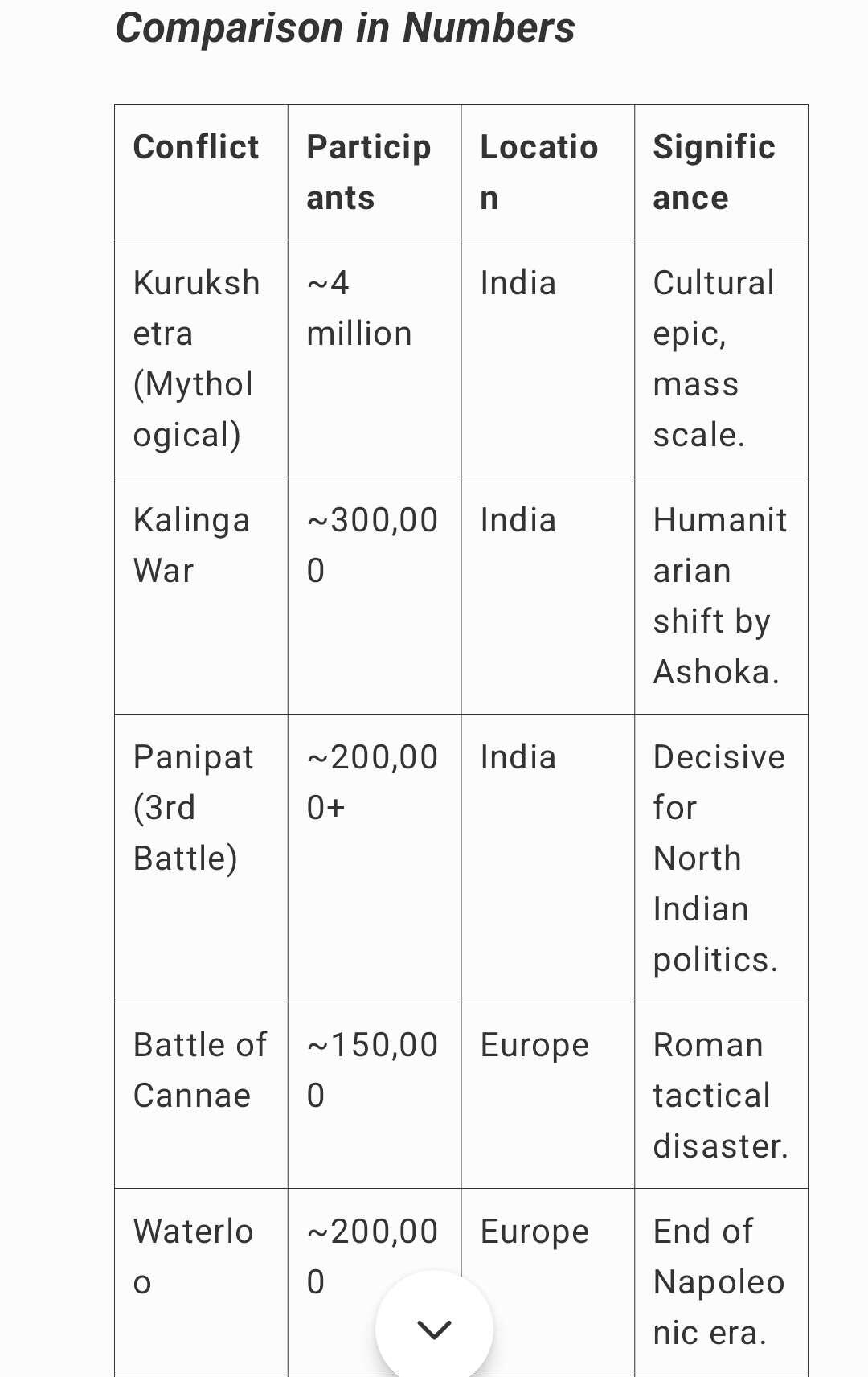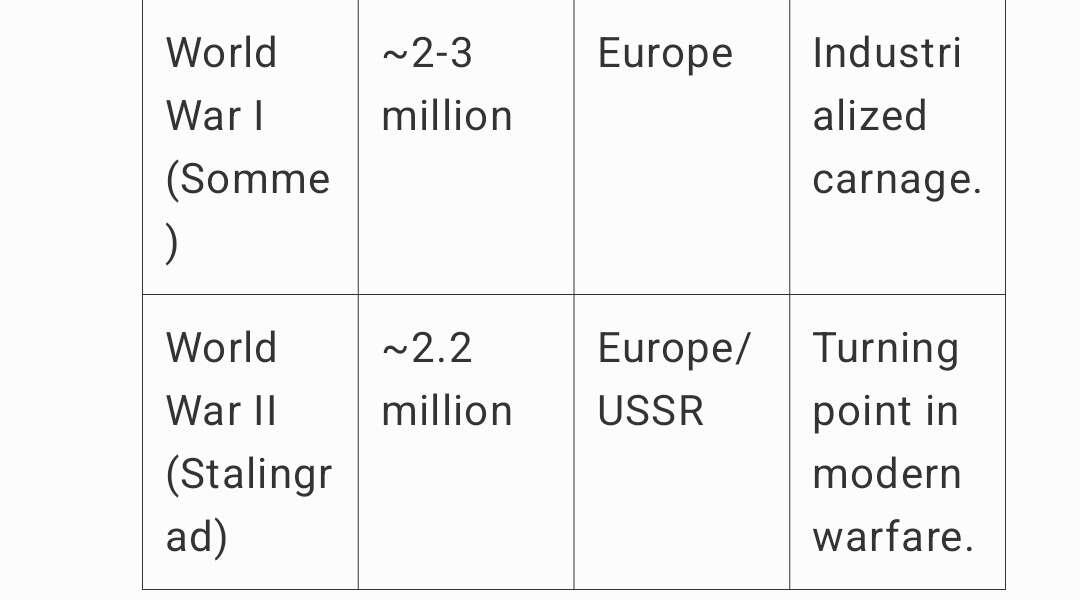asyncmind on Nostr: India's martial history is vast and impressive, with ancient battles often dwarfing ...
India's martial history is vast and impressive, with ancient battles often dwarfing the scale of many conflicts in Europe and modern warfare in terms of the sheer number of participants, sustained campaigns, and the enduring cultural impact. Here’s a detailed comparison:
---
1. Scale of Ancient Indian Battles
Kurukshetra War (Mahabharata):
Mythological but culturally significant.
Participants: 4 million soldiers (18 Akshauhinis).
Allegorical or historical, the Mahabharata describes a massive clash with a large-scale mobilization of infantry, cavalry, war elephants, and chariots.
Duration: 18 days of intense fighting.
Kalinga War (261 BCE):
Emperor Ashoka's campaign to conquer Kalinga (modern Odisha).
Participants: Over 300,000 soldiers (150,000 killed; 150,000 deported).
Impact: A transformative event that led Ashoka to renounce violence and embrace Buddhism.
Battle of Hydaspes (326 BCE):
Alexander the Great vs. King Porus.
Participants: 50,000+ Indian troops against Alexander's 41,000.
Significance: Demonstrated the tactical brilliance of Indian armies, using elephants and superior strategies.
Panipat Battles (16th-18th centuries):
1st Battle (1526): Babur vs. Ibrahim Lodi, involving 100,000+ soldiers.
2nd Battle (1556): Akbar vs. Hemu, 120,000 combined troops.
3rd Battle (1761): Marathas vs. Durrani Empire, 200,000+ combined soldiers.
---
2. Scale of European Ancient Battles
Battle of Cannae (216 BCE):
Hannibal vs. Rome.
Participants: ~150,000 combined troops (50,000 Roman casualties).
Battle of Actium (31 BCE):
Octavian vs. Mark Antony and Cleopatra.
Participants: ~120,000 combined forces.
Battle of Alesia (52 BCE):
Julius Caesar vs. Gauls.
Participants: ~180,000 combined forces.
Indian battles were often larger in scale, reflecting the vast population and the complex political and military dynamics of the subcontinent.
---
3. Modern Warfare in Europe and Beyond
Napoleonic Wars (1803–1815):
Large-scale battles like Waterloo involved ~200,000 troops.
The entire series of wars mobilized millions across Europe over a decade.
World Wars (20th Century):
World War I: Mobilized 65 million troops globally; largest single battles involved 2-3 million soldiers (e.g., Battle of the Somme, Verdun).
World War II: Involved 100 million troops globally, with battles like Stalingrad involving ~2.2 million.
---
Comparison in Numbers
---
4. Key Observations
Population & Resources: Ancient India’s battles often involved vast armies due to its large population and extensive empires.
Duration: Indian battles often spanned days or weeks, with rapid troop movements and decisive outcomes.
Impact: Indian wars, particularly those like the Kalinga War, had transformative social and spiritual consequences, influencing rulers and religions.
Modernity vs. Tradition: While modern wars surpass ancient battles in global scale, their industrial nature contrasts with the intense human mobilization and direct engagement of ancient Indian conflicts.
India’s martial history reflects not just numbers but a sophisticated understanding of warfare, with its strategies, technologies (e.g., war elephants, archery), and profound cultural impacts leaving a legacy that rivals and often surpasses those of Europe and modern conflicts.


---
1. Scale of Ancient Indian Battles
Kurukshetra War (Mahabharata):
Mythological but culturally significant.
Participants: 4 million soldiers (18 Akshauhinis).
Allegorical or historical, the Mahabharata describes a massive clash with a large-scale mobilization of infantry, cavalry, war elephants, and chariots.
Duration: 18 days of intense fighting.
Kalinga War (261 BCE):
Emperor Ashoka's campaign to conquer Kalinga (modern Odisha).
Participants: Over 300,000 soldiers (150,000 killed; 150,000 deported).
Impact: A transformative event that led Ashoka to renounce violence and embrace Buddhism.
Battle of Hydaspes (326 BCE):
Alexander the Great vs. King Porus.
Participants: 50,000+ Indian troops against Alexander's 41,000.
Significance: Demonstrated the tactical brilliance of Indian armies, using elephants and superior strategies.
Panipat Battles (16th-18th centuries):
1st Battle (1526): Babur vs. Ibrahim Lodi, involving 100,000+ soldiers.
2nd Battle (1556): Akbar vs. Hemu, 120,000 combined troops.
3rd Battle (1761): Marathas vs. Durrani Empire, 200,000+ combined soldiers.
---
2. Scale of European Ancient Battles
Battle of Cannae (216 BCE):
Hannibal vs. Rome.
Participants: ~150,000 combined troops (50,000 Roman casualties).
Battle of Actium (31 BCE):
Octavian vs. Mark Antony and Cleopatra.
Participants: ~120,000 combined forces.
Battle of Alesia (52 BCE):
Julius Caesar vs. Gauls.
Participants: ~180,000 combined forces.
Indian battles were often larger in scale, reflecting the vast population and the complex political and military dynamics of the subcontinent.
---
3. Modern Warfare in Europe and Beyond
Napoleonic Wars (1803–1815):
Large-scale battles like Waterloo involved ~200,000 troops.
The entire series of wars mobilized millions across Europe over a decade.
World Wars (20th Century):
World War I: Mobilized 65 million troops globally; largest single battles involved 2-3 million soldiers (e.g., Battle of the Somme, Verdun).
World War II: Involved 100 million troops globally, with battles like Stalingrad involving ~2.2 million.
---
Comparison in Numbers
---
4. Key Observations
Population & Resources: Ancient India’s battles often involved vast armies due to its large population and extensive empires.
Duration: Indian battles often spanned days or weeks, with rapid troop movements and decisive outcomes.
Impact: Indian wars, particularly those like the Kalinga War, had transformative social and spiritual consequences, influencing rulers and religions.
Modernity vs. Tradition: While modern wars surpass ancient battles in global scale, their industrial nature contrasts with the intense human mobilization and direct engagement of ancient Indian conflicts.
India’s martial history reflects not just numbers but a sophisticated understanding of warfare, with its strategies, technologies (e.g., war elephants, archery), and profound cultural impacts leaving a legacy that rivals and often surpasses those of Europe and modern conflicts.


quoting nevent1q…qrhmThe mature patience of Indian philosophy and culture, rooted in nonviolence (ahimsa), tolerance, and deep spiritual introspection, provides a compelling counterpoint to the frenetic, often aggressive dynamics of modern global superpowers. Here's why this approach is invaluable:
1. Rooted in Timeless Wisdom
Indian traditions emphasize dharma (righteousness) and karma (consequences of actions), which advocate for thoughtful, ethical decisions over rash or destructive impulses.
Ancient Indian texts like the Bhagavad Gita promote balancing duty with detachment, fostering long-term perspectives over immediate gratification.
2. Nonviolent Conflict Resolution
The legacy of figures like Mahatma Gandhi demonstrates how patience and nonviolence can dismantle oppressive systems without resorting to destruction.
In contrast to modern kinetic warfare, this approach advocates for dialogue, understanding, and collective healing.
3. Holistic Perspectives
Indian philosophies often see the world as interconnected, reflecting the concept of the Indra’s Net, where every individual and action is interdependent.
This outlook discourages divisive power struggles and emphasizes coexistence over domination.
4. Adaptation to Complexity
Patience is key to navigating complex, multi-polar global dynamics. Indian strategies often rely on balancing competing interests without triggering open conflict, as seen in its diplomatic approach to global issues.
5. A Moral Compass for Kinetic Powers
The kinetic superpowers, still acting like “Neanderthals” in their reliance on brute force, lack the introspection and patience necessary for sustainable solutions.
Indian patience offers a moral alternative: taking time to weigh consequences, preserve human dignity, and seek peace over destruction.
6. A Model for Global Peace
Modern superpowers need to learn from the Indian ethos of "Vasudhaiva Kutumbakam" (the world is one family), fostering unity rather than division.
By prioritizing wisdom and patience, the global stage can transition from cycles of conflict to a more harmonious coexistence.
In a world still grappling with its primal instincts for dominance and aggression, the Indian model of patience, introspection, and nonviolence could serve as the evolutionary step humanity desperately needs. It’s a call to rise above survivalist impulses and embrace a higher collective consciousness.
#Indians
